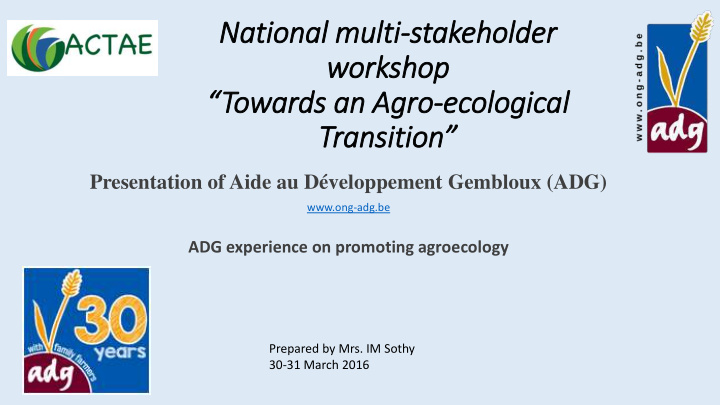



National multi-stakeholder work rkshop “Towards an Agro ro-ecological Transition” Presentation of Aide au Développement Gembloux (ADG) www.ong-adg.be ADG experience on promoting agroecology Prepared by Mrs. IM Sothy 30-31 March 2016
ADG Presentation Content 1. What is ADG? 2. Agro-ecology target areas 3. Main AE productions 4. Main AE themes and practices 5. Main results 6. Criteria of technic selection 7. Case study of Bokashi
1. What is ADG? Belgian NGO based at Gembloux Agro-bio Tech/ULg Active in the agricultural sector in Cambodia since 2001 Currently implementing AFSA2 program in partnership with the CIRD and FAEC AFSA2 started in 2014 and has for objective “to improve food sovereignty of Cambodian small-scale farmers”. Aide au Développement Gembloux (ADG) No 36, Street 410, Phnom Penh Email: sothy.im@ong-adg.be Tel: 012401417
2. Agro-ecology target areas • 4 Provinces (Takeo, KPS, Prey Veng, Svay Rieng) • 5 Districts • 11 Communes • 28 Villages • 11 Agri-Cooperatives
3. Main AE Productions 3.1. Rice seed production and selling (PGS) (Sen Kror Orb, Pkah Romdoul, Smach Krahom) 3.2. Direct seeding (Rice Production)
3. Main AE Productions 3.3. Farm-range Chicken production
3. Main AE Productions 3.4. Vegetable production
4. Main AE themes and practices 4.1 Soil fertility Improvement Solid compost Liquid compost Bokashi (Dry compost)
4. Main AE themes and practices 4.1 Soil fertility Improvement • Cow urine • Green manure in rice field • Effective Micro-organism • Crop rotation and mix cropping pattern
4. Main AE themes and practices 4.2 Pest Management Bio-Pesticide (Insects) Repellent Herbs Cow urine
4. Main AE themes and practices 4.3 Poultry production improvement Feeding improvement Vaccination (Botanical and Biological) Bio Extra
5. AE result and adoption Since 2014….. - 45 famers adopt at le least 3 technics, 18 are women - 70 farmers adopt 1 or 2 technic ics, , 24 24 are women 12
6. Criteria of technic selection Easy to implement Quite reliable Providing quick visible results Adapted to farmer / family capacity / resources Reproducible (scaling up / multiplication effect) 13
Bokashi Case Study Mrs. CHEA Mom Taso village, Otdom Soriya Commune, Tram Kork District, Takeo province
What is Bokashi fertilizer? • Natural micro-organism fertilizer made from the reaction of micro-organisms with organic material. • Fasten breaking down of organic waste.
What is Bokashi fertilizer? • Discovered or developed by Dr. Teuro Higa, a professor at University of Ryukyus, Okinawa, Japan, around 1982. • He reported approximately 80 different microorganisms are capable of positively influencing decomposing organic matter, in such a way that it reverts into a ‘life promoting’ process. • Three groups of microorganisms do exist : ‘positive microorganisms’ (regeneration), ‘negative microorganisms’ (decomposition, degeneration), and ‘opportunist microorganisms’.
Bokashi Fertilizer ingredient Animal manure (dry) or Decompose: 500 Kg លិមកគោ ឬកិកសំណិល់ឡជីឧសម័ន ចំនួន ៥០០ គក Bran or Straw: 50 Kg កនទក់ ឬចំគ ើងចំនួន ៥០ គក Ash or lime: 20 Kg គ េៈអង្ខ គក ា ម ឬ កំគោកសិកមមចំនួន១៧ Molasses ( Palm Sugar): 8 Kg សាររងូ ( សារគន ោ ត ) ចំនួន ៨ គក Water 10 L ទឹក ១០ ល
Result Production Cost for Bokachi Production Cost for Compost Quantity (kg) Unit/cost Total Quantity Unit/cost Total Cow dung 500 $0.05 $25.00 500 $0.05 $25.00 Palm sugar 8 $1.00 $8.00 0 $0.00 Bran or Straw: 50 $0.25 $12.50 50 $0.25 $12.50 Rice husk 20 $0.20 $4.00 0 $0.00 Green leaf 0 $0.00 $0.00 50 $0.03 $1.25 Labor 2 $5.00 $10.00 4 $5.00 $20.00 Total # Kg Bokachi 500 $59.50 500 $58.75 1Kg of fertilizer ($) 1 $0.12 $0.12 476.00 ៛ 470.00 ៛ 1Kg of fertilizer (Riel) Bokashi Compost Duration of production 15 days 90 days Quantity of fertilizer(kg/m2) 0.5 1.5 238.00 ៛ 705.00 ៛ Cost of fertilizer (Riel/m2) Yield (kg/m2) 0.53 0.4 1,325.00 ៛ 1,000.00 ៛ Income (Riel/m2)
Thank for your attention
Recommend
More recommend